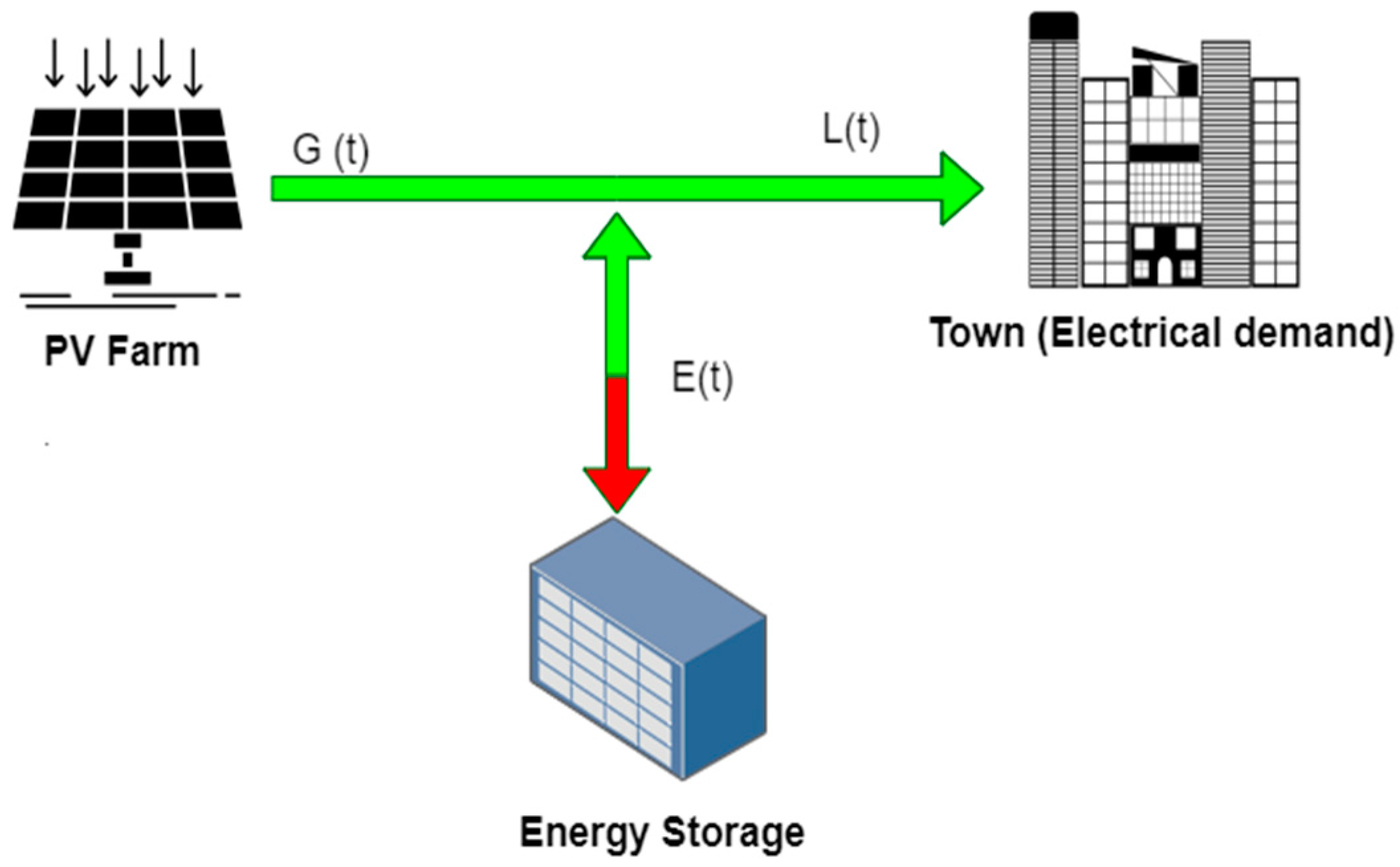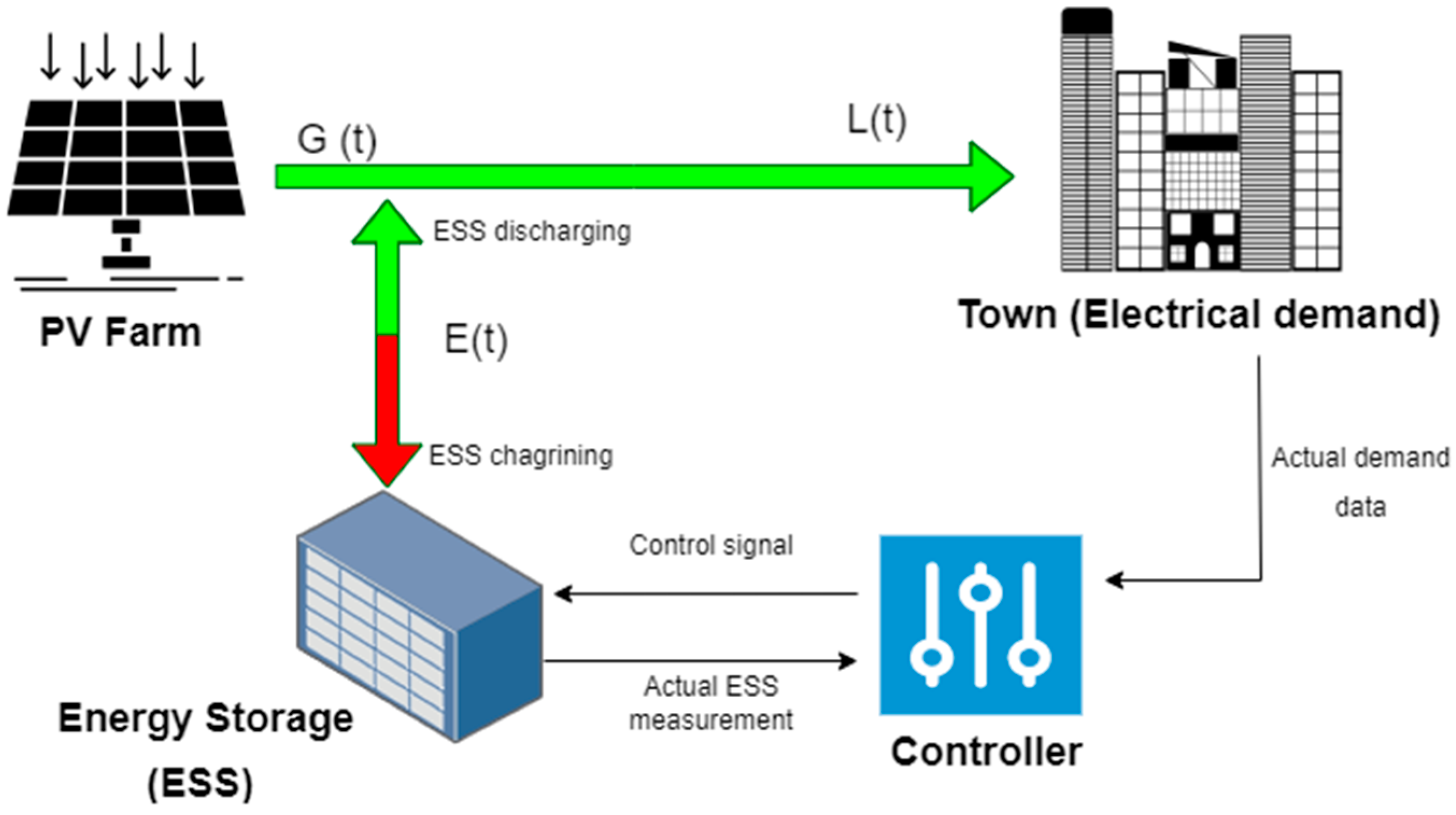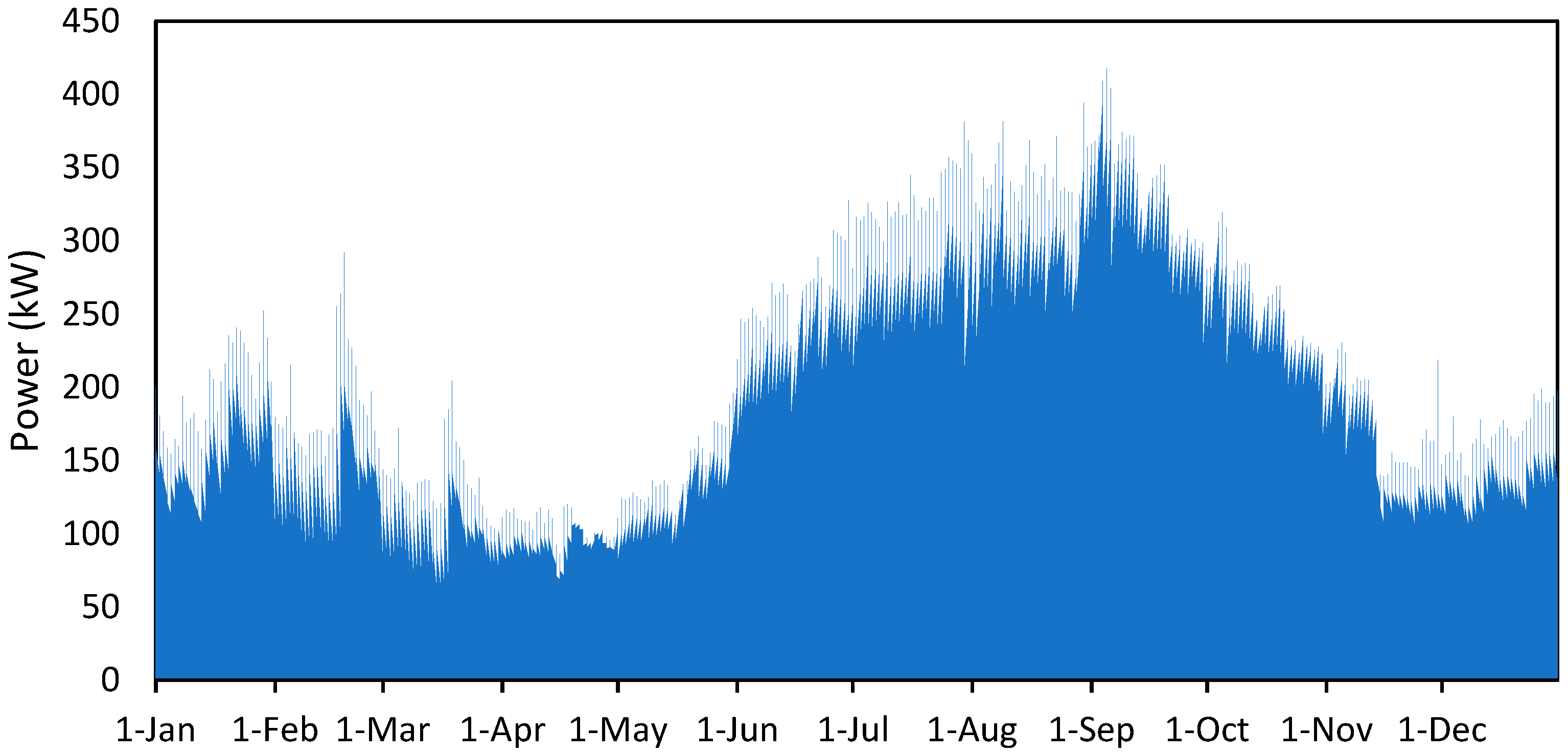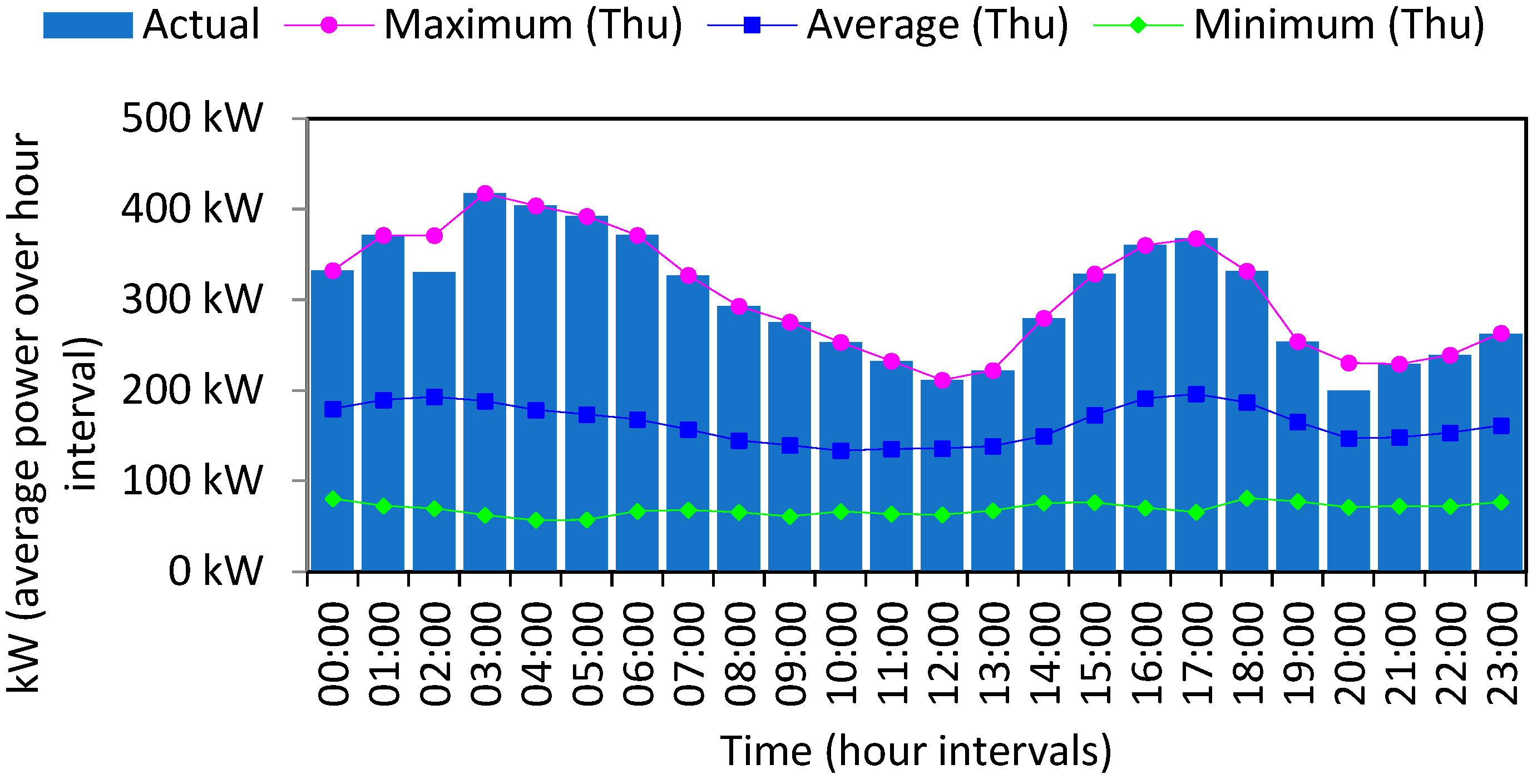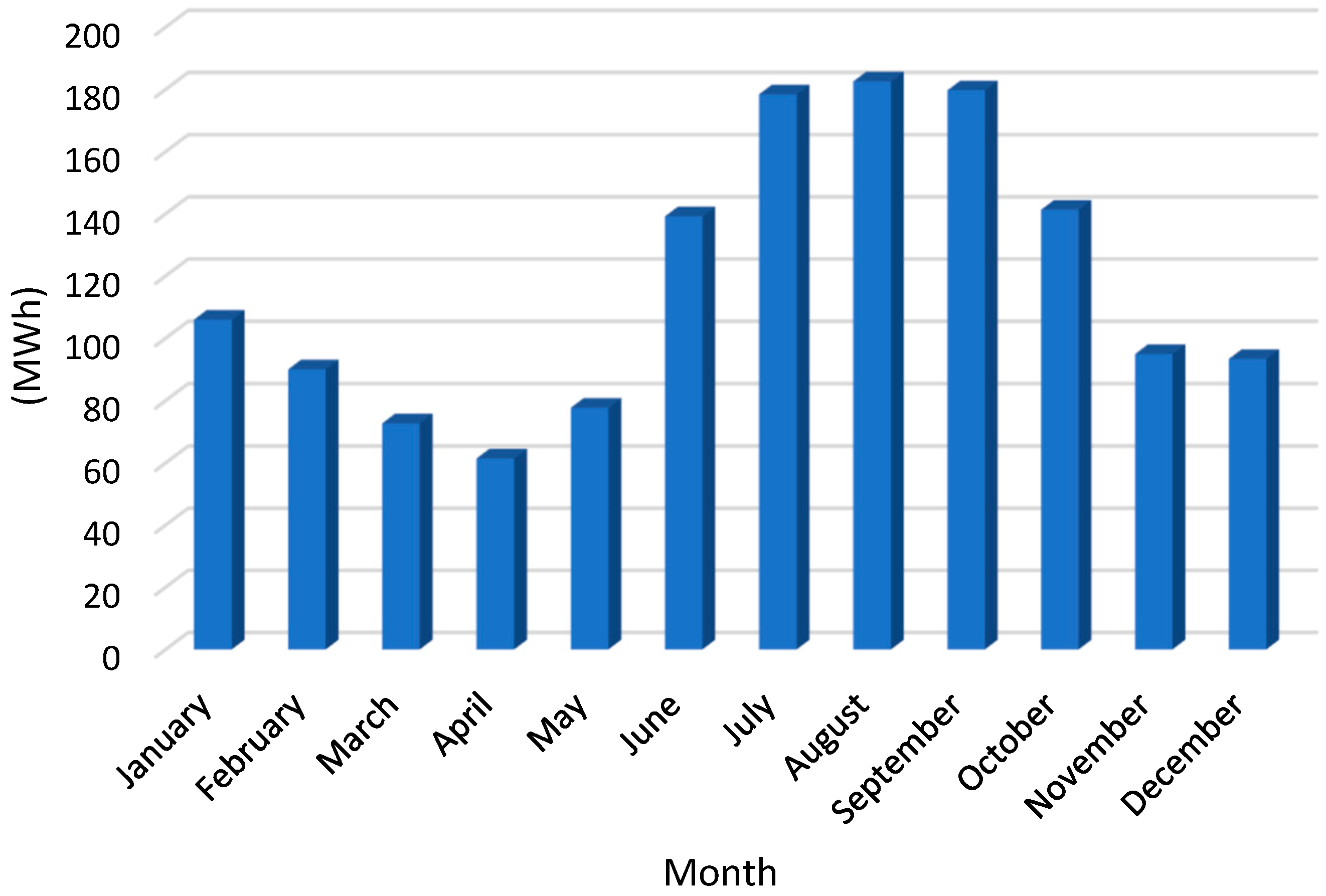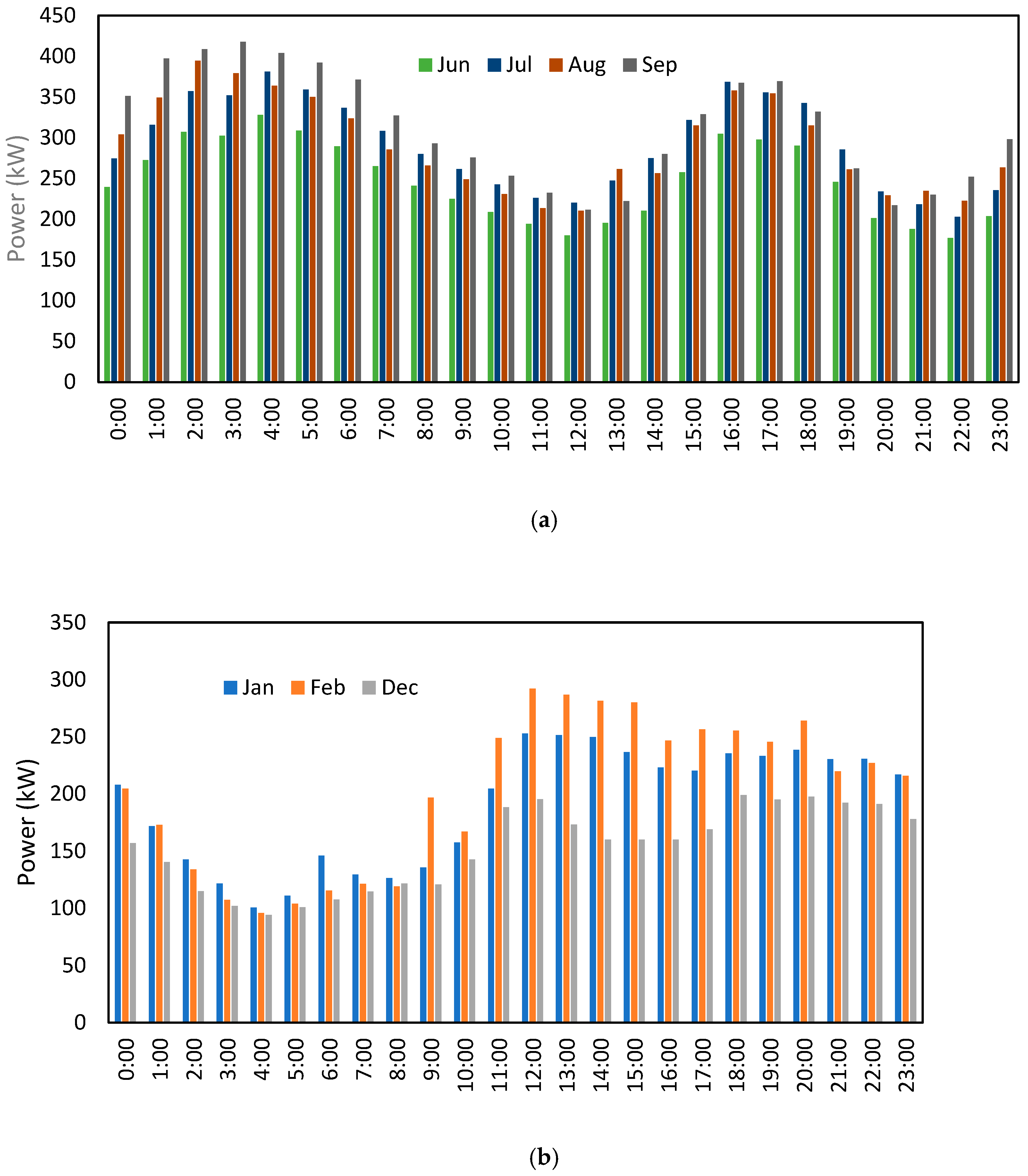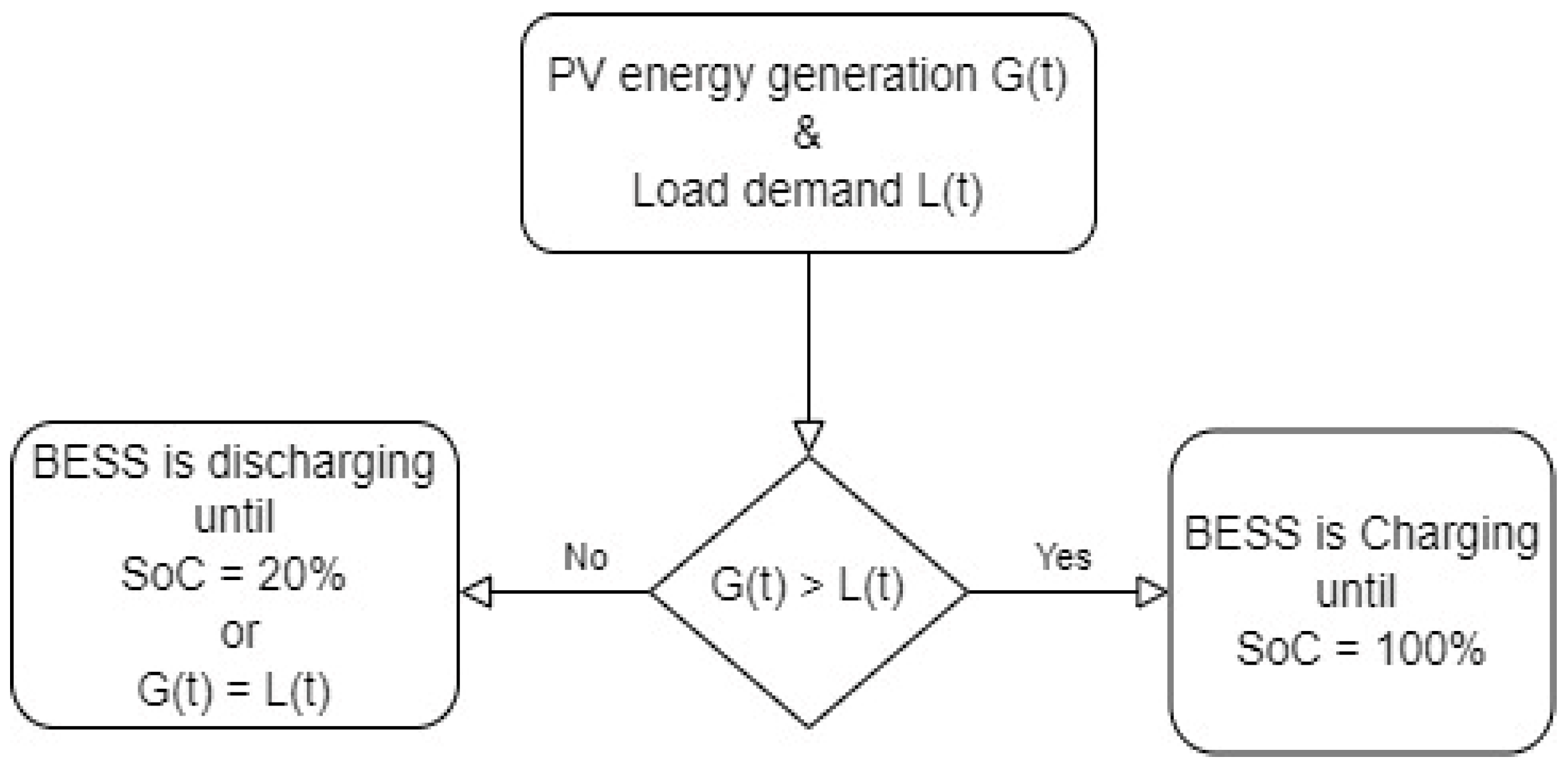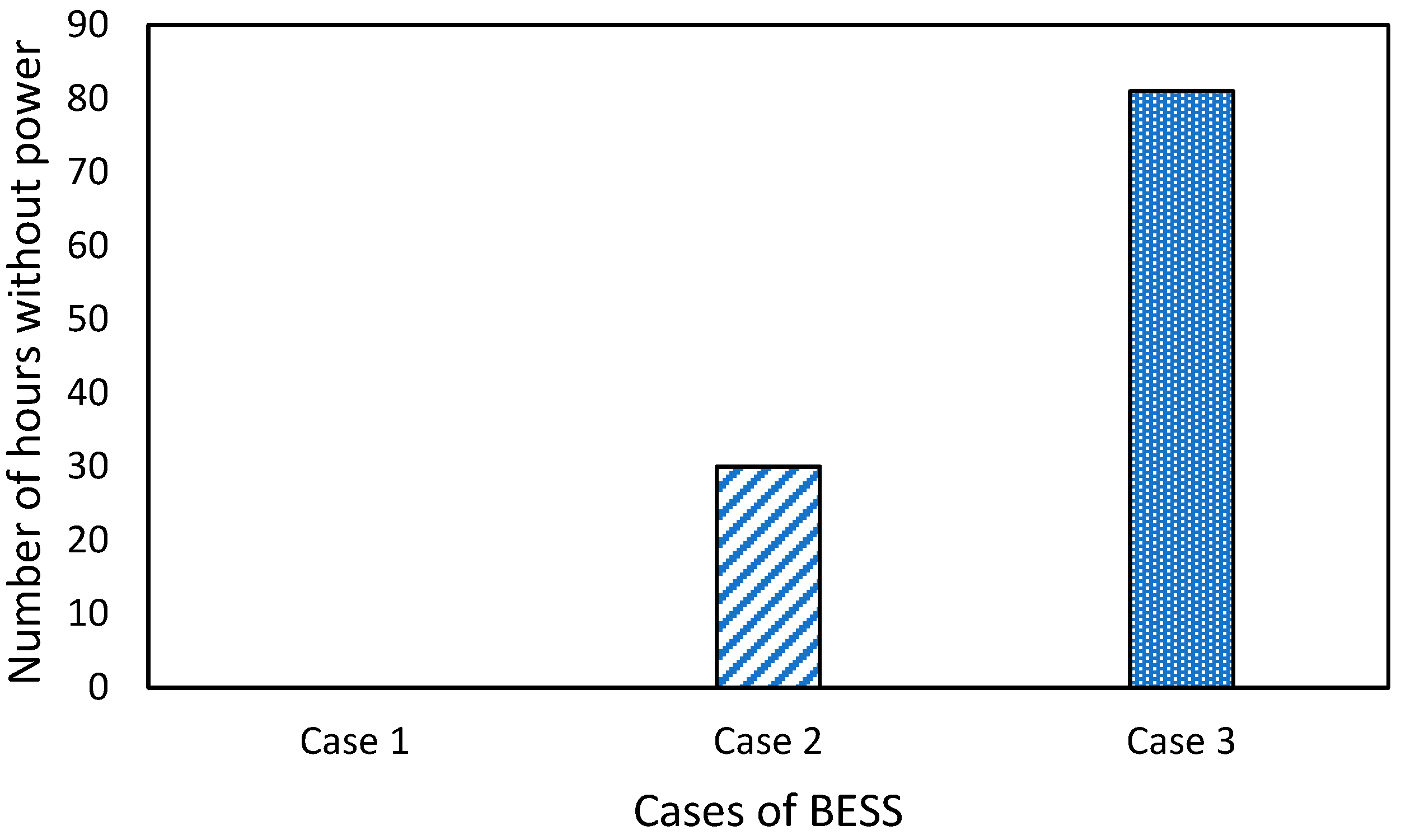This section aims to introduce the 100% PV and ESS systems for microgrid topology and the optimal controllers for the ESS. Firstly, the schematic energy flow diagram, as shown in
Figure 1, shows the flow of energy from the main energy source (the PV system
) and ESS,
, to the demand side of the gird,
The energy flow diagram presents that the PV system,
, supplies all the required electrical energy consumption,
, and charge to the storage device (
with the red arrow, in
Figure 1). However, in the case of discharging the ESS, (
with the green arrow,
Figure 1), the PV system,
, will supply the energy of the grid demand,
, minus the discharged energy from the ESS. The energy flow can be described as follows [
1,
2,
3]:
In addition, this work aims to develop and present an optimal energy controller for the ESS to improve the power network performance compared to the common energy controller, the set-point algorithm [
25]. The optimal energy controller aims to find the optimal ESS operation condition (charging and discharging).
Figure 2 introduces the proposed energy control loop for the microgrid system. The actual electrical demand and the ESS measurements are fed to the energy controller to generate a control decision to optimally charge or discharge the energy storage. The main components of the proposed system in this paper, as presented in
Figure 2, will be discussed in the following subsections.
2.2. Sizing of the PV System
In general, the size of the PV system depends on different terms such as the scale of the project (small, medium, or large scale) and location. The impact of location on the PV system is related to the ambient conditions (temperature and solar radiation) which affect the efficiency of the PV system (energy production) [
2,
5]. In this section, the annual and monthly averaged values of global horizontal irradiance (GHI), direct normal irradiation (DNI), diffuse horizontal irradiation (DIF), and global tilted irradiation at an optimum angle (GTI) were downloaded from the solar energy database provided (SolarGIS website) [
26]. The annual average GHI is 5.485 kWh/m
2 per day which introduced this location as a significant location for installing PV systems with a high level of solar radiation, as shown in
Table 1 and
Figure 12. In addition, from April to September, the irradiance level is more than 6 kWh/m
2 per day. The solar radiation in summer is significantly higher and reaches above 8 kWh/m
2 per day in June and July, whereas in winter it still records a sufficient level of radiation with an amount of around 3 kWh/m
2 per day in December and January.
A power network based on a 100% RES system with high-reliability performance in microgrids was the main goal of this study. The size of the PV system considering the different load demand scenarios is presented in
Table 2. Equation (2) was used to calculate the size of the PV systems,
in kW [
5]:
where
is the average daily load energy (kWh/day),
is the average direct sunlight hours within the day, and
is the PV system efficiency. In this work, the
was considered to be 0.79 and
to be 5.485 kWh/hour-day. The data analysis in the previous section showed the stochastic behaviour of the load demand, as shown in
Figure 9. Therefore, the size of the PV system was investigated in this work based on a different level of demand by using Equation (2), as follows:
A computational model called photovoltaic yield simulation [
27] was used to calculate the PV out generation (kWh) on monthly bases for the different PV system scenarios, as presented in
Table 4. The results in
Table 4 show that the three PV system scenarios provided the required electrical energy over the year as yearly power generation and load demand consumption. However, in terms of monthly load demand consumptions, the PV system (scenario 1) was not able to cover it 100% compared to scenarios 2 and 3.
Table 4 presents the percentage of coverage for the total daily demand by the PV power generation over a year. For example, the total load demand in December was approximately 93 MWh which was not able to be achieved by the generation of the PV system (scenario 1) with 89 MWh. In terms of daily load demand consumptions, the PV system was able to cover the required load demand by 52.3%, 95.61%, and 80.72% for scenarios 1, 2, and 3, respectively. Therefore, there is significant potential for covering the required daily demand by developing an optimal energy management system including an ESS.
2.3. Sizing of ESS
ESS is introduced into the power network, as described in Equation (1), as a solution to guarantee to cover the load demand and match between PV power supply and demand. In this article, the power network was developed based on an isolated network scenario; therefore, ESS (lithium-ion battery) was used for the intermittency of a 100% PV system.
Figure 13 introduces a basic flow chart for the operation of the power network with ESS. To determine the size of the EES, techno-economic analysis needs to be performed, usually under different defined assumptions. Firstly, the background of the case study needs to be identified such as load profile scenarios, the PV generation size, and profiles and the sun irradiation profile. The required background has been presented and discussed in
Section 2.1 and
Section 2.2. The load demand refers to Al-Mashari’e town in Irbid with a mean hourly power of 164 kW, while the peak power reached 420 Kw and the total energy demand over a year was 1417.5 MWh. The PV plant was investigated in the previous section with three scenarios to match PV power supply and demand. Scenario 2 with a peak power equal to 1363.02 kWp covered the town demand for 95.61% of the days in the year. The total energy production from the PV plant (scenario 2) was 2202.6 MWh. Furthermore,
Table 5 presents the monthly energy consumption during the night period with an average of 72.9 MWh/monthly and 2.4 MWh/day. The maximum monthly demand during nights was during August with 115.2 MWh.
With regard to the ESS (lithium-ion battery) specification and re-electrification performance [
25,
28], the inverter efficiency is set to 85% and the charge/discharge efficiency is 90%. Then, the minimum and maximum State of Charge (SoC) is set to be equal to 20% and 100%, respectively [
25,
28]. In this work, the main task of the ESS was to help the PV system match the demand during the night and autonomy days (when the PV generation was less than the load demand), as shown in
Figure 13. In addition, this control process for the BESS is called the set-point control model.
Based on the previous analysis, Equation (3) is used to determine the size of the battery system [
6,
25]:
where the
is the size of the battery storage system in kWh,
is the days of Autonomy (2 day),
is average daily demand during the night period in kWh/day, DoD is the depth of discharge,
is the efficiency of the inverter,
is the charge/discharge efficiency, and
is a safety factor. Furthermore, the size of the energy storage system will depend on the role of this storage such as frequency controlling or peak shaving. The ESS size was chosen to cover the daily demand based on the kWh term by using Equation (3), as presented in [
6,
25]. The size of the BESS and main specification are summarized in
Table 6 from the literature [
6,
25]. There are also different factors that can affect the size of the ESS such as the location of the ESS in the network.
The location of the energy storage system in the microgrid also has a direct impact on the size and performance of the storage model [
29,
30]. In general, the location of the energy storage system on the network depends on the role of this storage. For example, a central energy storage system located on the distribution substation to cover the town demand will help to reduce the total peak and cover the total demand of the town and control it in total. In addition, the central energy storage will support the substation to mitigate the operational constraints and reduce the thermal and voltage problems at the substation in this zone [
25,
28]. In another scenario, the energy storage system can be divided into smaller sizes and located near the load or on the distribution feeders, as distributed energy storage system. In this scenario, the distributed energy storage system will help to reduce the peak, control the demand, and minimize thermal and voltage problems on the cables at the end of the feeder. However, the distributed energy storage system will have a limited impact on controlling the total demand or reducing the thermal problem at the substation [
25]. Therefore, the location of the energy storage system depends on the role of the storage in the network. In this work, the covering of total demand and cost-saving performance were considered which led to the central storage system being located at the substation. A comparison analysis for the central and distributed energy storage system will be discussed in
Section 3.
In addition, the effective controlling of the energy storage system, demand response (DR), and the dynamic thermal rating (DTR) system will help to improve the network performance [
30,
31]. The controlling of the energy storage system and DR aim to cover the load demand and reduce peaks and blackouts [
25,
31]. The DTR is mainly used to enhance the capacity of the power lines and mitigate the thermal constraints of the power lines by considering the advantages of the variability of power line rating based on the fluctuations of the weather conditions [
30,
31]. Therefore, the DTR can help to improve the performance of the power network and minimize the size of the required ESS [
31]. In this work, the thermal rating for the power lines (voltage and current) has not been studied; the controlling of ESS is the main technique used to improve the network performance and the focus is on covering the total demand and energy cost-saving performance.
2.4. Optimization Operation Method for the BESS
The power sources, the PV plant, and the BESS feed the required load demand consumption to cover 100% of the power network demand, as shown in
Figure 1. Let L, as described in Equation (4), be the hourly load demand of the network over more than one day (two days):
The basic operation of the BESS is presented in the previous section as shown in
Figure 13. In this section, an optimal BESS controller is introduced and developed to achieve the optimal operation plan for the BESS over a day. The objective is to minimize the function,
(t), which is described as the status of not covering 100% of load demand by PV and BESS over the day.
The BESS model presented in this section has been introduced by the authors of [
25]. The BESS model works under a number of constraints, as presented by Equations (6) and (7). In general, The SoC at the time step t is
is required to be within the minimum and maximum SoC value,
, and
, respectively, and the charging/discharging energy E(t) restricted to lower and upper limits (
). The
shows the stored energy in the BESS which depends on the previous status of the BESS,
E(t), and the efficiency of the BESS,
, [
25,
28] as follows:
The energy flow problem is formulated in Equation (5); the BESS control loop is introduced in
Figure 2. As stated in
Section 1, optimally controlling the BESS normally shows significant increases in the reliability of the power system. Therefore, new metaheuristic optimization algorithms (GROM and PSO) have been used in this paper to improve the economic and energy performance of 100% PV and ESS systems for microgrids by solving the optimization problem in Equation (5). The optimal BESS controller based on GROM and PSO will aim to find the optimal operation plan of the BESS. Here, the
is the charging or discharging energy for the BESS at time t and to describe the BESS plan or operation sequence over a day, the
.
